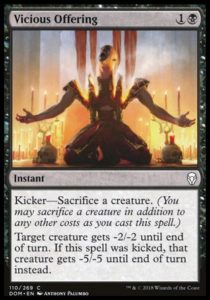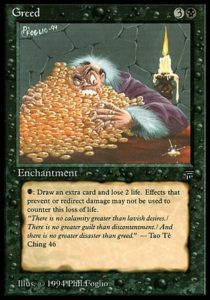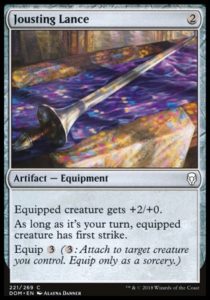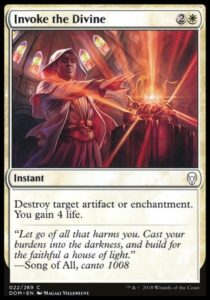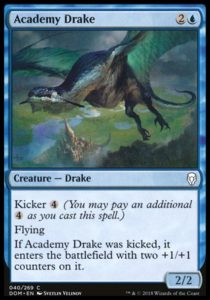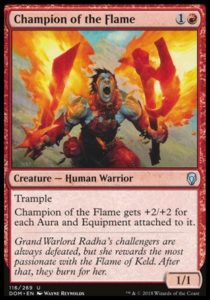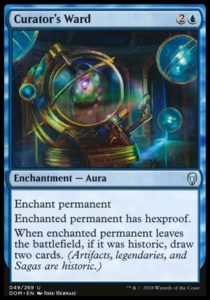For the past few years, blocking has not been a particularly strong strategy. Limited has seen oodles of 3+ power creatures for two and three mana. Standard has had to deal with Hazoret the Fervent, Glorybringer, and Heart of Kiran as undercosted, nearly unblockable beaters. Blocking was more often a matter of chump-blocking rather than two creatures bouncing off of each other.
Well, Dominaria’s changed all of that. Sure, it’s still got a 3/3 for two in Bloodstone Goblin, but its hoop to jump through is much more difficult and inconsistent than Tilonali’s Knight, Nef-Crop Entangler, or Thriving Gremlin. Two-mana 2/2s are fairly bad in formats where 1/3s are excellent, and Vodalian Arcanist, Caligo Skin-Witch, and Ghitu Chronicler are excellent. So, what does this mean? How does a format change if blocking is good?
The Value of Removal
In aggressive formats like Amonkhet and Ixalan, removal was often less important than creatures or combat tricks. Pious Interdiction isn’t very impressive when it’s trading down for a Headstrong Brute, and Magma Spray was amazing because it could kill Gust Walker. There were simply too many powerful, cheap creatures to kill, and they often dodged expensive removal spells via cheap combat tricks like Dive Down and Vampire’s Zeal. We’ve seen a lot of formats were removal was essential, but was too often overwhelmed by the sheer abundance of threats.
In Dominaria, removal is less important for staying alive, because you can often blank your opponent’s threats with your own creatures. However, removal is essential for not losing to a bomb—a resolved and uncontested Tatyova, Benthic Druid or even a Knight of New Benalia equipped with Dub or On Serra’s Wings will likely win the game by itself.
The primary purpose of Dominarian removal is preventing your opponent from taking over the game with a massive threat. You should be careful to save your interaction for a must-kill threat. Sure, it’d be nice to Eviscerate that Cloudreader Sphinx so your Wingrace Acolyte can attack, but you’ll look pretty foolish when your opponent plays a Thorn Elemental or Zahid, Djinn of the Lamp. Sometimes you should save your Shivan Fire even if it’ll get you a two-for-one when your opponent plays Gift of Growth, because it can kill Slimefoot, the Stowaway.
Life and tempo are less valuable
Outside of Fight With Fire, Slimefoot, the Stowaway, and Keldon Overseer, there aren’t mana ways you can get burned out. Accordingly, you can be a bit more liberal with your life total. It’s okay to take a bunch of damage early if you can stabilize behind a wall of creatures. Even if your opponent does 15 to you with a Dubbed Knight of New Benalia, they might have little gas left in the tank when you Blink of an Eye it. Dominaria games tend to go long, and that’s where card advantage, rather than tempo or life advantage tend to shine.
That said, that doesn’t mean you can freely take damage. Cards like Pegasus Courser can do surprisingly large amounts of damage. If you don’t have a means of blanking them (like Cloudreader Sphinx or Mammoth Spider), you should proactively kill them (since you’ll have to do it eventually, anyway). Sometimes you should blow up up your opponent’s Knight of Malice to let your team crash in, but more often than not you’ll be rewarded for patience, rather than tempo-positive plays.
Jousting Lance is Very Good
The power level of the average Dominarian common creature is low. Creatures are rarely larger than a 3/3. Games are drawn out and players often have plenty of mana. All of these criteria favor equipment like Jousting Lance. Suddenly, your 2/2s eat anything smaller than a 4/4, transforming them from minor annoyances to major problems. Your creatures all trade up or demand removal spells, which clears the way for your bombs or just lets the lance take over the game.
Short Sword, however, is still not great. Upgrading your 2/2 into a vanilla 3/3 is hardly impressive when your opponent can just double block with their 2/2s.
Disenchant is Removal
Some of the most powerful threats and removal spells in the format can be hit by Invoke the Divine, Broken Bond, and Fiery Intervention. Icy Manipulator, In Bolas’s Clutches, Deep Freeze, Song of Freyalise, and Jousting Lance are all powerful spells that are difficult to answer. You want to run a Disenchant or Naturalize wherever possible to answer them. You can even blow up On Serra’s Wings or Dub mid-combat for the opponents who are trying to combo-kill you out.
If you don’t have access to white or green, blue can still provide some answers with Blink of an Eye and Syncopate (which is quite good in this slow format).
Evasion is Great
When board stalls are easy to come by, evasion is great. Outside of Mammoth Spider and the mythic rare Multani, Yavimaya’s Avatar, there is no reach in the format. Every flying creature is good, because it presents a clock that your opponent has to deal with and demands an answer. That answer is one that won’t be pointed at your Tatyova or Shanna, Sisay’s Legacy.
Don’t Durdle too much
Divination and Dark Bargain are excellent spells, but you can’t afford to do too much nothing. If you don’t draft some defense you’ll either die to or be forced to remove a Deathbloom Thallid (neither is a good option). You also run the risk of dying to someone who turns Champion of the Flame into an 8/7 flying menace out of nowhere while your Eviscerate sits helplessly in your hand. Dominaria is a slow format with poor aggressive mechanics, but it is by no means devoid of aggression. You need to have a plan for the faster decks, even if (right now) the slower decks seem way better.
Wrapping Up
Dominaria looks to be quite different from what we’ve seen lately. It has pleasantly bucked the trend of recent large set limited formats. Its speed, its mechanics, its play patterns, and even its approach to design are all quite refreshing. There a ton of minute interactions, methods of squeezing out advantage, and crazy powerful cards. Change is good, and Dominaria brings a whole lot of it to Limited and Standard (and if you’ve seen this past weekend’s Team SCG Open, to nonrotating formats, well). Here’s looking forward to several more months of this sweet new format.
And, as always, thanks for reading.
—Zachary Barash
Zachary Barash is a New York City-based game designer. He works for Kingdom Death: Monster, has a Game Design MFA from the NYU Game Center, and does freelance game design. When the stars align, he streams Magic.
His favorite card of the month is Ghitu Chronicler. For two mana less than Archaeomancer, you get a Straw Soldiers. For two mana more, you get an Archaeomancer with one extra point of toughness. Someone, the combination of these two components yields a more powerful card than the more straightforward one. It all goes to show how powerful flexibility and Kicker are. …unless you’re playing Ghostly Flicker, then everything I just said is wrong.

